
Mopping up around a giant sequoia

News and opinion about wildland fire

(Originally published at 7:01 MDT, September 7, 2015)
A firefighter was burned today on the Rough Fire. Below is a news release from the incident management team:
At approximately 8:00 [on September 7, 2015], a firefighter was injured while working in the Converse Basin area of the Rough Fire. The firefighter was part of a hotshot crew working the night shift tasked with monitoring the fire line along Hoist Ridge, looking for spot fires that may have occurred outside the containment line.
Given the extremely steep, rugged terrain, a Rapid Extraction Module (REM) was dispatched to remove the firefighter from the scene to a road. The firefighter was delivered to an ambulance and transported to a nearby helispot. A helicopter then transported the patient to the hospital for treatment. The firefighter was conscious and alert at the time of the extraction.
The firefighter is now in the hospital, receiving treatment, in stable condition and good spirits. The firefighter’s family has been notified and is en route. The Forest Service is providing an employee advocate who is on scene to work with the firefighter’s family and medical staff to facilitate communication with all involved parties and deal with any needs of the family.
The Rough Fire, which started on July 31 east of Fresno, California, has burned over 95,000 acres.
Does anyone have details of what comprises a “Rapid Extraction Module” on a wildland fire?
****
(UPDATE September 8, 2015)
Our readers can provide a wealth of information.
Thanks and a tip of the hat go out to Barbara. Typos or errors, report them HERE.
(UPDATED at 11:51 a.m. PT, September 14, 2015)

The Rough Fire has grown by almost 20,000 acres in the last three days and is now listed at 138,053 acres.
Below is an excerpt from an update by the incident management team Monday morning:
Firefighting efforts are being made during day and night shifts on the Rough Fire to further the containment lines, which have now reached 40% over the whole fire.
Crews and Engines continue to patrol Grant Grove checking for any escaped embers with potential to start a spot fire. Structure defense crews are in place around residential areas near the fireline including, Sequoia Lake, Hume Lake, and Cedar Grove. These firelines are holding well and being monitored closely.
Weather will be slightly cooler today through Wednesday with areas of dense smoke thinning by the afternoon, making aerial firefighting efforts more productive.

At about 11:30 a.m. Monday the on-scene incident meteorologist said light rain was falling over some portions of the fire.

****
(UPDATED at 9 a.m. PT, September 11, 2015)
New evacuations were ordered at 6 a.m. Friday near the Rough Fire for some locations south of Highway 180 and west of Highway 245. The details can be found at InciWeb, where they also have a difficult to read map unless you are able to zoom in.
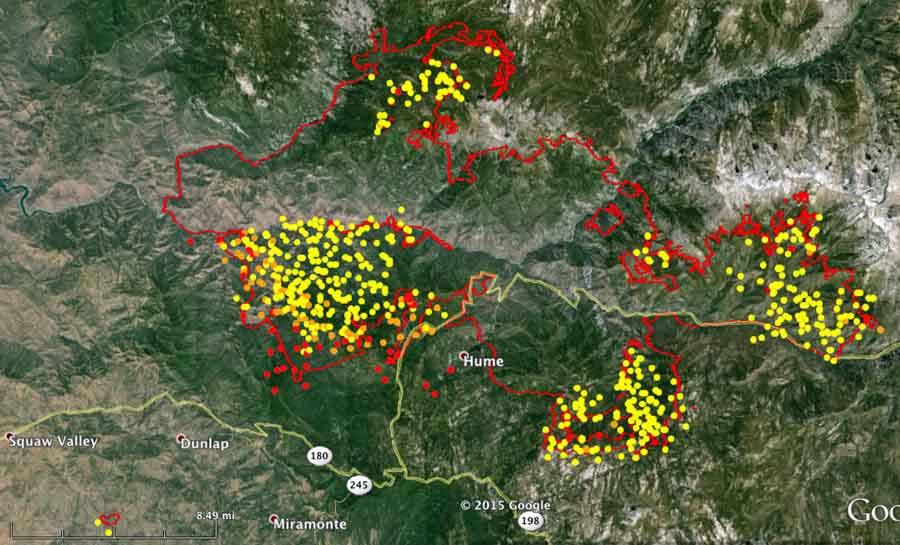
The fire has burned 119,069 acres 32 miles east of Fresno, California and continues to spread on the southwest side. Thursday night firefighters began a burnout along Highway 180 from Indian Basin south toward Cherry Gap working toward the northwest portion of Grants Grove, which has already been evacuated. Friday morning they described it as successful with containment lines reaching 400 to 500 feet wide in some places.
The eastern portion of the fire remains active near Cedar Grove and is expected to continue to spread to the east and northeast.
****
(UPDATED at 10:27 a.m. PT, September 10, 2015)
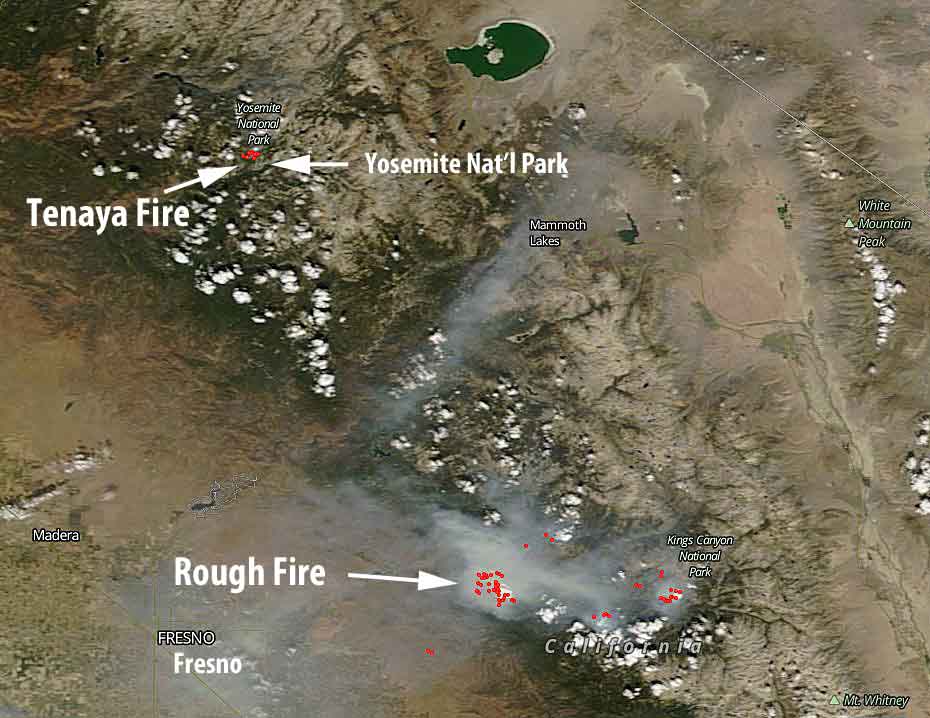
The Rough Fire east of Fresno, California was very active Wednesday and continues to spread on the east and southwest sides. It has grown to 110,134 acres, crossing the 100,000-acre threshold to become a “megafire”.
Tuesday night the Fresno County Sheriff’s Department issued additional evacuation notices for homes west of the fire. Thursday morning the National Park Service issued an evacuation order to park visitors, park employees, concessions staff, and residents of Wilsonia in the Grant Grove area of Kings Canyon National Park. The NPS is working with the Sheriffs’ Departments of both Fresno County and Tulare County to provide the evacuation notifications.
Highway 180 is closed at the Big Stump Entrance Station. The Generals Highway, sometimes referred to as Hwy. 198, is closed at the Red Fir gate, which is west of Wuksachi Village. Sequoia National Park remains open and visitors can still use the Ash Mountain Entrance Station. Vehicles longer than 22 feet (including trailers) are not advised between Potwisha and Giant Forest Museum.
Very little information about the fire has been released by the incident management team since Wednesday morning.
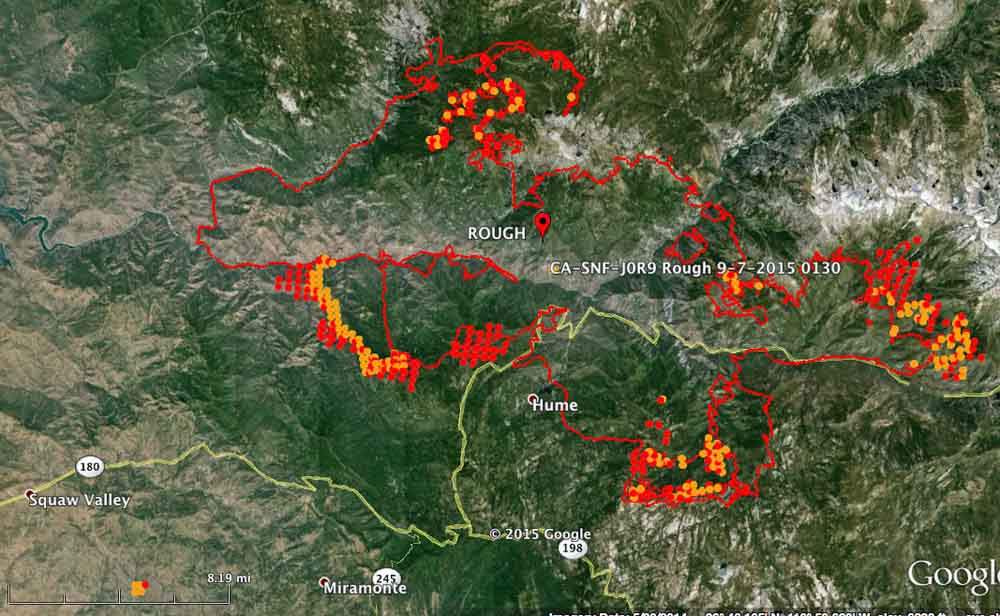
Continue reading “Light rain hits the Rough Fire in California”

The Rough Fire east of Fresno, after burning for more than a month, will be transitioning from a Type 1 incident management team to a National Incident Management Team (NIMO) from Boise (Reinarz) and a Type 3 team. This new organization “will manage the entire incident”, according to South Zone News and Notes. Pechota’s Type 1 IMT “will be transitioning into command [Friday]” on the south part of the fire, South Zone News and Notes reported on Thursday.
The fire is being staffed by 1,901 personnel and has grown to 81,549 acres. The Team is calling it 25 percent contained.

Below is an excerpt from an update on the fire, provided by the incident management team the evening of September 2, 2015:
****
“The SCSIIMT (Cooper) will be transitioning to a Sierra National Forest Type Three Organization who will be assuming responsibility for the continuing fire suppression and support activities. In addition, a National Incident Management Organization (NIMO) will arrive during this transition.
Fire crews continue to gain ground on the fire in the Crown Valley trailhead area. Containment lines are being established in conjunction with mop up operations along the fire line. Fire suppression repair work is underway on some of the fire affected areas. This work will help with possible soil erosion in case of a water event.
The Wildland Fire Modules are finishing their backfiring operations in the John Muir Wilderness supported by a pack string of mules to limit helicopter flights in the wilderness. In addition, the High Sierra OHV crew continues to support fire personnel with deliveries and removal of hose and tools in difficult terrain.
Weather during the morning and early afternoon prevented firing operations from taking place in the south zone. Crews continued to reinforce lines in the Hoist Ridge and Buck Rock areas in preparation for burn operations tonight, weather permitting.
The fire has continued to push east along the north side of Highway 180. It is currently about two miles from Cedar Grove. Vulnerable structures in this area have been wrapped, and hose lines placed in preparation for the approaching fire. Crews are working to bring the fire north toward Stag Dome in an effort to keep it away from the lodge area.”
****
Related:

This article first appeared on the InciWeb page for the Rough Fire, which has burned 66,542 acres near Hume Lake in southern California. Fire managers are calling it 25 percent contained.
****
“Indonesia, which is comprised of a group of 17,500 islands, is considered one of the most disaster prone areas in the world. Not do the mountains move (147 active volcanos), but the ground around the mountains seems to shake with earthquakes daily, reportedly with at least a 5.0 tremor every day. On December 26, 2004 Indonesia recorded the third largest earthquake ever recorded with the longest duration of faulting ever observed. It caused the entire planet to vibrate as much as 1 centimeter and triggered other earthquakes as far away as Alaska.
Shortly after the 2004 earthquake, the government realized that the country needed a system to help manage disasters. The government approached the United States to teach and provide technical expertise on the Incident Command System (ICS) for the tsunami-prone areas. A series of training courses was conducted in partnership with the governments of Sri Lanka and Indonesia.
18 individuals from Indonesia who are considered trainers arrived at the Rough Fire on August 28. They will be traveling to big cities in California to learn and participate in certain aspects of the ICS over the next few weeks. They expected that by arriving in the month of August they would have the opportunity to see the ICS at work during a large incident.
“The Team” will be at the Rough Base Camp to observe certain sections of the command system, so they can pass along their knowledge and educate the other Indonesians about ICS. On one particular Island, the team stated they have over five thousand trained volunteers. Many islands in Indonesia are difficult to access, similar to The Rough Fire. The team has changed the name of the management system to “Indonesian Command System”.”
****

(This article is no longer being updated, but there was an update on Wildfire Today on September 3, 2015.)
****
(UPDATE at 6:45 a.m. PT, August 24, 2015)
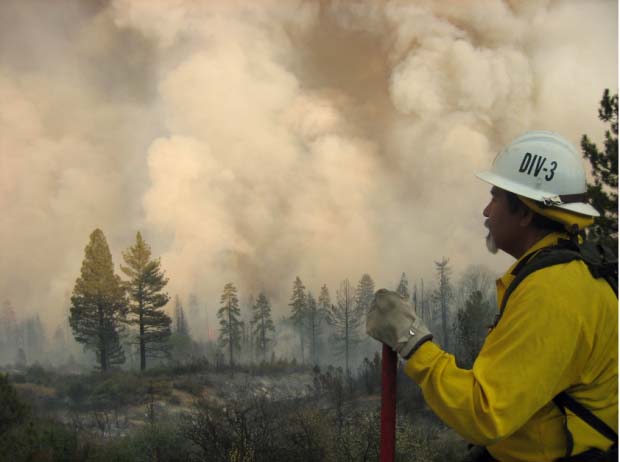
The Rough Fire just east of Hume Lake, California was fairly active again Sunday afternoon in multiple areas. As a result of fire activity and firing operations, the burned area increased approximately 2,000 acres to a total of 49,440 acres or 77 square miles.
Direct fire suppression continued southwest of Hume Lake near Landslide Campground. The objective of this operation is to stop the southern spread south of Hume Lake and east of the Kennedy Grove area. Aircraft continue to be used for these direct suppression operations.
Crews conducted hand firing near Balch Camp on Sunday. The fire made a run up canyon and burned laterally across the slope approximately ¾ miles from Balch Camp. Retardant is being dropped from helicopters to build a retardant line from the river up slope to check the fire spread.
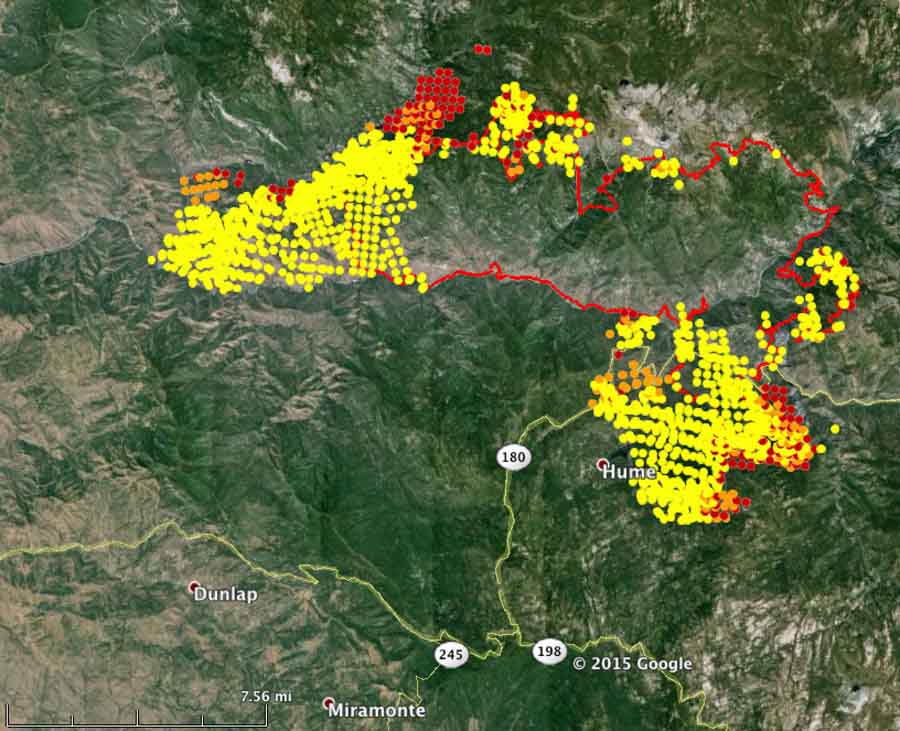
The Grant Grove and Wilsonia areas of Kings Canyon National Park will reopen in stages Monday and Tuesday. At noon on Monday the General Grant Tree, Panoramic Point, park trails, John Muir Lodge, Grant Grove Cabins, restaurant, market, and gift shop will open. On Tuesday at 8 a.m., the Kings Canyon Visitor Center will reopen, and at noon Tuesday Sunset Campground will open.
****
(UPDATE at 11:15 a.m. PT, August 22, 2015)
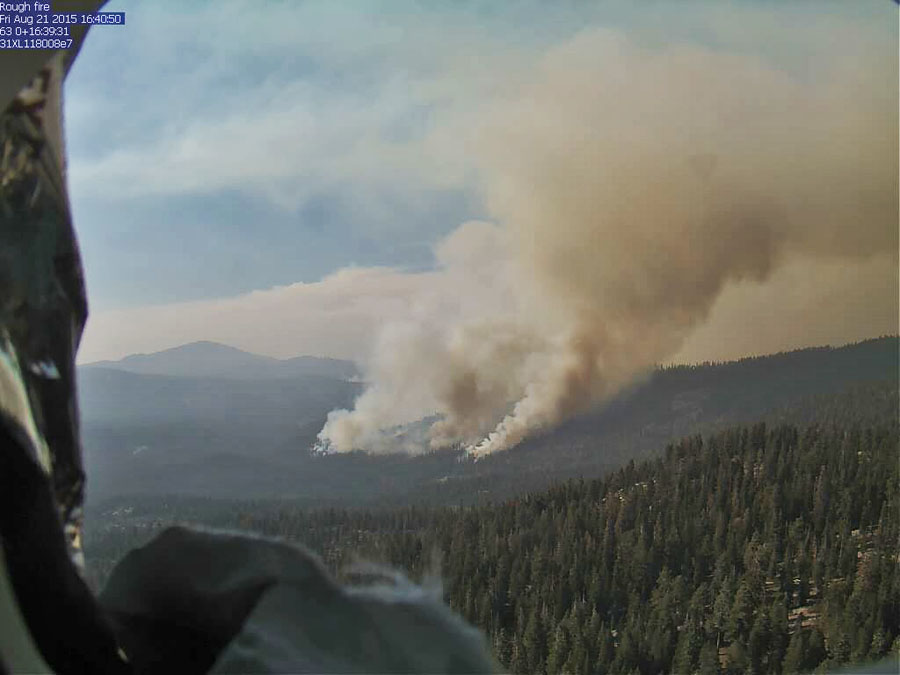
The Rough Fire at Hume Lake, California, 36 miles east of Fresno, has spread south of Hume Lake and continues to grow on the west side north of Kings River and Highway 180. The incident Management Team is calling it 47,079 acres. Approximately 1,484 personnel are assigned to the incident.
Continue reading “Rough Fire, east of Fresno, CA, continues to spread near Hume Lake”